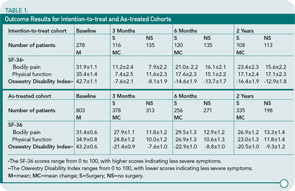SPINAL STENOSIS
Is Surgical Decompression the Best Treatment for Lumbar Spinal Stenosis?
By David G. Borenstein, MD
Weinstein JN, Tosteson TD, Lurie JD, et al. Surgical versus nonsurgical therapy for lumbar spinal stenosis. N Engl J Med. 2008;358:794-810.
Abstract
Background: Surgery for spinal stenosis is widely performed, but its effectiveness as compared with nonsurgical treatment has not been shown in controlled trials.
Methods: Surgical candidates with a history of at least 12 weeks of symptoms and spinal stenosis without spondylolisthesis (as confirmed on imaging) were enrolled in either a randomized cohort or an observational cohort at 13 U.S. spine clinics. Treatment was decompressive surgery or usual nonsurgical care. The primary outcomes were measures of bodily pain and physical function on the Medical Outcomes Study 36-item Short-Form General Health Survey (SF-36) and the modified Oswestry Disability Index at six weeks, three months, six months, and one and two years.
Results: A total of 289 patients were enrolled in the randomized cohort, and 365 patients were enrolled in the observational cohort. At two years, 67% of patients who were randomly assigned to surgery had undergone surgery, whereas 43% of those who were randomly assigned to receive nonsurgical care had also undergone surgery. Despite the high level of nonadherence, the intention-to-treat analysis of the randomized cohort showed a significant treatment effect favoring surgery on the SF-36 scale for bodily pain, with a mean difference in change from baseline of 7.8 (95% confidence interval, 1.5 to 14.1); however, there was no significant difference in scores of physical function or on the Oswestry Disability Index. The as-treated analysis, which combined both cohorts and was adjusted for potential confounders, showed a significant advantage for surgery by three months for all primary outcomes; these changes remained significant at two years.
Conclusions: In the combined as-treated analysis, patients who underwent surgery showed significantly more improvement in all primary outcomes than did patients who were treated nonsurgically.
Commentary
In 2005, the Cochrane Review group reported the lack of clear or decisive data concerning the efficacy of surgical decompression for treating spinal stenosis. Although clinical studies on surgical therapy have been published, they have been limited by, among other things, the inclusion of patients with spinal instability (spondylolisthesis) who required fusion as a component of surgical therapy. The studies included small groups of patients without significant improvement from surgical intervention. In response to paucity of clinical trials studying an adequate number of similar stenosis subjects, the Spine Patient Outcomes Research Trial (SPORT) group completed a clinical trial investigating the relative benefit of surgical versus nonsurgical therapy for patients with spinal stenosis without spondylolisthesis.

